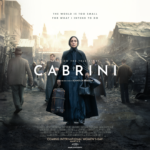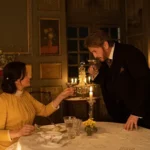For the life of me, I cannot recall what made me choose it, but for at least a year the “wallpaper” on my computer screen has been a digital copy of Rogier van der Weyden’s portrait of Mary Magdalene.
The right panel of what is now called the “Braque Triptych” (the left panel is John the Baptist, while the center features Mary, Christ, and St. John the Evangelist), Rogier’s painting was produced in oil on oak as an altarpiece, privately commissioned most likely for Catherine of Brabant around 1450.
The entire triptych is approximately four feet across, by no means a large piece but more than adequate for a noble’s private chapel; the “Mary Magdalene” panel, like the left panel, is perhaps a foot in width. It resides in the Louvre today, which means I may never see it, a sad but realistic thought that makes me all the more grateful for modern prints and the Internet.
The Mary Magdalene who greets me every time I go to my laptop is visually stunning. Its perspective shows notable development beyond medieval art: the background vista indicates a skilled grasp of the vanishing point although the trees and nearby hillside remind me ever so slightly of the images I’ve seen in old-fashioned stereoscopes.
No matter. It’s Mary that draws one’s full attention.
First of all, her clothes are both elaborate and modest. The eye is drawn almost immediately to the gold of her sleeves with overlaying webs in what seems to be scarlet, the color associated simultaneously and appropriately here with prostitution and the blood of Christ. The rest of her dress is much simpler, even incongruously so, with a bodice of mid-blue and a cloak, also blue but the color of midnight. A white undergarment provides a border above the “vee” of the bodice.
The effect overall might be understood as a movement from self-display to self-effacement, and, indeed, one might easily plot Mary’s history, what we gather about it, in exactly that way. She wears a Renaissance headdress swathed with a sheer kerchief that hangs loosely under her chin, an anachronism, to be sure, but one that places her not simply in first-century Judea but in all time.
Physically, she is a beautiful woman: fair complexion, brown or hazel eyes, full but not over-large lips, and slightly reddish-to-auburn hair (depending on the quality of the print) that falls down her back. Although she looks to the viewer’s left, in fact toward Christ in the center of the triptych, her face is all but fully displayed. The expression is arresting. The mouth is more or less in a straight line; the eyes stare into a distance the viewer cannot see although, as suggested above, in terms of the overall work’s program her destination is Christ Himself.
What’s in the face? Before we can fully answer that, we must know where Mary is, and Rogier has not left us in doubt.
Each panel in the Braque Triptych has an inscription from the Gospel of John. Mary’s (chapter 12, verse 3) reads: “Then took Mary a pound of ointment of spikenard, very costly, and anointed the feet of Jesus, and wiped his feet with her hair: and the house was filled with the odor of the ointment.” Alfred Acres once observed that the “Mary” panel is different from the other two in that her words are not hers at all but the Evangelist’s about her. Mary, then, is silent, as if she knows that nothing she can say will justify her past. And in the Biblical passage, Mary says nothing.
In the panel, Mary is not yet in Christ’s presence. Her expression hints at various emotions. Certainly, one detects real determination, as one may gather from the set mouth; the eyes, however, suggest fear and doubt, the feelings any sinner might find roiling inside as a meeting with the Lord becomes imminent. And, of course, one can readily imagine her shame and humility that have come from heart-rending self-knowledge.
Although it’s hard to discern at the bottom of the panel, she is apparently sitting, perhaps in something like a sedan chair. Her left hand is under her cloak, but the right-hand rests on a covered jar containing the ointment she will pour on Christ’s feet. That hand does little more, I believe, than steady her cargo that is, as the Gospel says, “very costly.” But her eyes remain steadily fixed on her real destination.
That destination is—for Mary and for us in this season of Lent—the Lord Himself. Like her, we approach Him in a spirit of self-examination mirrored in those small Lenten disciplines in which we deny ourselves—who knows?—chocolate or wine, which, properly understood proclaim a denial of self. This spirit of mourning for the selves we once were, with its determination to journey on toward a rebirth so radical we hardly know what it is, radiates sublimely in Rogier’s Mary Magdalene.
Mary has gotten to be an old friend of mine as I see her each day, and, as much as I like variety, I have no plans of removing her picture from my computer screen. She’s a reminder that notorious sinners, which is what we all are, may move, albeit with fear and trembling, toward Christ, bearing the gift of self-denial that finds its ultimate reward in Him.















Medieval Art, which I am always defending anymore, has more heart and refinement than many modern works albeit we have a better knowledge of perspective and anatomy. Rogier was not only aware of Jan Van Eyck’s Ghent Altarpiece, he actually knew the artist. He had dinner with Jan in Tournai at a banquet given in Jan’s honor along with Robert Campin. I have a theory the couple in the distance, in his painting of St. Luke drawing The Virgin and Child with a silverpoint, are Van Eyck and his wife Margaret. Thank you for the meditation, you chose a great work by a painter I love.
Carl C. Curtis, thank you ever so for you post.Much thanks again.
Carl C. Curtis, thanks! And thanks for sharing your great posts every week!